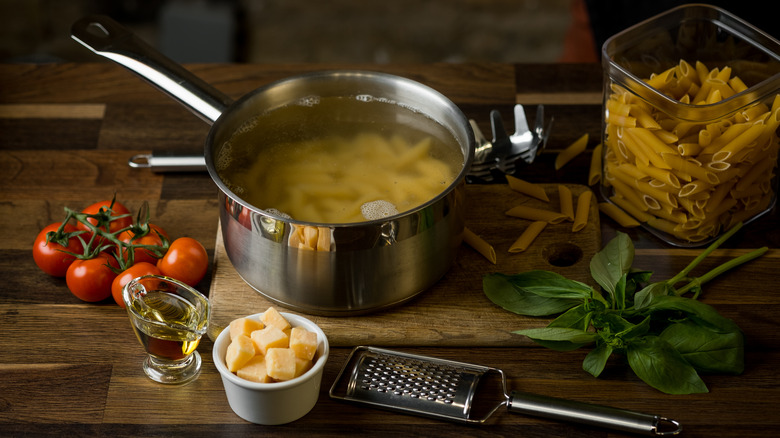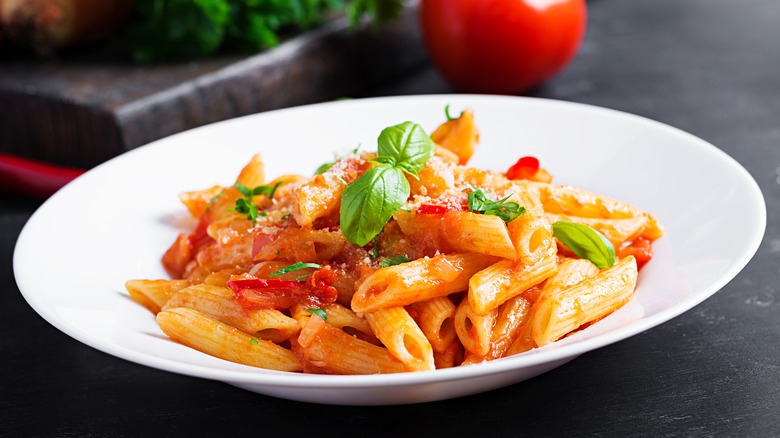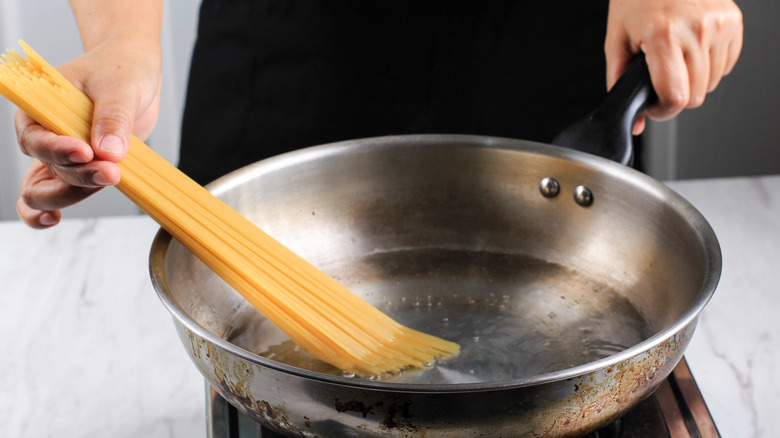The Cold Water Hack That Cooks Pasta Faster Than You Can Eat It
If you want to cook dried pasta the traditional way, there are a couple of standard rules that pretty much everyone accepts: The pan must be large enough so that the pasta has room to move about, and there should be plenty of water that has come to a boil before you add the noodles.
Even so, one clever kitchen hack is becoming increasingly popular that turns all of that tradition on its head by essentially advising the exact opposite when it comes to the boiling water part. This so-called cold water hack skips the heat and involves a much smaller amount of agua; in fact, just enough to cover the pasta by about an inch. The noodles then cook as the water heats up.
There are several benefits to this unique cooking method, which is even endorsed by celebrity chef Alton Brown. First, there's the speed. While waiting for a huge pan of water to come to a boil takes some time, the cold water method is much faster, which comes in handy when you're looking for quick pasta recipes for easy weeknight dinners. It also uses less energy, since the stove is on full blast for a shorter period of time, saving your utility bill and the environment.
The cold water hack leads to silkier sauces, too
Who doesn't want a silky, creamy sauce that evenly coats and clings to every piece of pasta? It's the holy grail when cooking noodles, and the good news with the cold water hack is that it actually helps to make pasta sauce a better consistency, too. The reason is due to the starches released as the pasta cooks. Because this hack uses less water (around a quart for a pound of pasta, depending on its shape), it means that the liquid at the end will contain more starch. And more starch means a velvety sauce that clings better.
To get the best results, you'll still want to season the pasta water with salt; if you want to know what properly salted pasta water should taste like, imagine a soup broth. In this case though, because you're using less water, you can also use a little less salt to get the same delicious result; around 1.5 teaspoons should be ample.
When you've got your pot of salted water ready, add in the pasta, and place it on a burner over high heat, stirring occasionally. When the water comes to the boil, pop a lid on, turn the heat to low, and cook for a minute or two less than the instructions on the box specify (around five minutes may be enough). When the noodles are al dente, use a pasta spider to drain your pasta without losing any water.
The hack does not work for every type of pasta
While the cold water hack produces quick and delicious results with many kinds of pasta, it will not work for every type. Fresh pasta, as opposed to dried, needs to be cooked in boiling salted water to achieve the desired texture. That's because it's made with eggs, so it requires boiling water to help it set and prevent it turning into a mushy mess.
Some pasta shapes will also cook better in less water than others. While shorter types such as rigatoni suit the smaller amount of cold water, other longer shapes, such as spaghetti, fettuccine, or linguine may not work as well. It can take a little longer for these shapes to become soft enough that they can fully submerge in water, and there's a chance that they could stick together as there's no room to move about so easily. Though, using a large enough skillet that allows the spaghetti to be fully under the water will help.
For an alternative hack to cook longer pasta shapes, you could try the pre-soaking method. This involves fully hydrating the noodles by submerging them in water, and then finishing the cooking process by putting the hydrated pasta in hot sauce. Or if your shapes are very small, such as orzo, you can completely skip the water and boil the pasta right in the sauce for fast and easy results.



